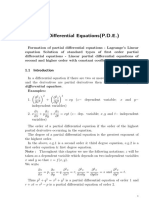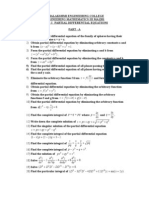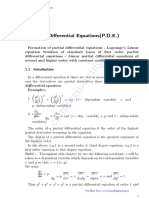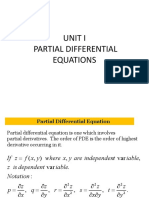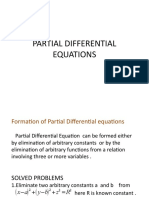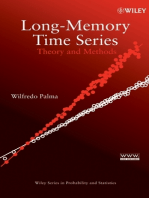Tutorial Sheet 1 - Unit 1
Uploaded by
td4520Tutorial Sheet 1 - Unit 1
Uploaded by
td4520SRM Institute of Science and Technology
Kattankulathur
DEPARTMENT OF MATHEMATICS
21MAB201T- TRANSFORMS AND
BOUNDARY VALUE PROBLEMS
UNIT - I Partial Differential Equations
Tutorial Sheet - 1
Sl. No. Questions Answer
Part - A
1 Form the PDE by eliminating arbitrary constants ‘a’ and ‘b’ from
(p2 q 2 1)z 2 c2
( x a ) ( x b) z c .
2 2 2 2
2 Form the PDE by eliminating arbitrary constants ‘a’ and ‘b’ from p q(z p)
log(az 1) x ay b .
3
Eliminate the arbitrary function ‘f’ from z f (x 2 y2 ). py qx
4 Solve p q 1
z ax (1 a )2 y c
5 Find the complete integral of pq p q 0. z ax
a
yc
a 1
Part - B
6
Form the PDE by eliminating ‘f’ from f ( x 2 y2 z 2 , xyz) 0. x ( y2 z 2 )p y(z 2 x 2 )q
z( x 2 y 2 )
7
Form the PDE by eliminating ‘f’ from z xy f ( x 2 y2 z 2 ) p( y xz) q ( x yz)
y2 x 2
8 Form the PDE by eliminating ‘f’ from xyz f ( x y z). x ( y z)p y(z x )q
z ( x y)
9 Form the PDE by eliminating ‘f’ and ‘g’ from
q 2 c2 p 2
z f ( x ct ) g(x ct ) .
10. Find the PDE by of the family of spheres having their centres on the line (y z)p (z x)q x y
x = y = z.
You might also like
- Unit-Ii: Partial Differential Equations-I: X y Yy XX XyNo ratings yetUnit-Ii: Partial Differential Equations-I: X y Yy XX Xy16 pages
- MA3351-TRANSORMS AND PARTIAL DIFFERENTIAL EQUATIONS- By www.notesfree.inNo ratings yetMA3351-TRANSORMS AND PARTIAL DIFFERENTIAL EQUATIONS- By www.notesfree.in160 pages
- MA3351 QB Part A - B 01 - by LearnEngineering - inNo ratings yetMA3351 QB Part A - B 01 - by LearnEngineering - in21 pages
- Note On PARTIAL DIFFERENTIAL EQUATIONS IndiaNo ratings yetNote On PARTIAL DIFFERENTIAL EQUATIONS India36 pages
- Module - 3 Partial Differential EquationsNo ratings yetModule - 3 Partial Differential Equations23 pages
- Course Handout MAT 201: Partial Differential Equations and Complex Analysis Module 1: Partial Differential EquationsNo ratings yetCourse Handout MAT 201: Partial Differential Equations and Complex Analysis Module 1: Partial Differential Equations37 pages
- Old Q Bank Ed-8.3 (Tutorial Sheet) of Maths IVNo ratings yetOld Q Bank Ed-8.3 (Tutorial Sheet) of Maths IV26 pages
- II Sem - Module 4 - Partial Diferential Equations - NotesNo ratings yetII Sem - Module 4 - Partial Diferential Equations - Notes17 pages
- MA8353 Transforms and Partial Differential Equations 02 - by LearnEngineering - in PDFNo ratings yetMA8353 Transforms and Partial Differential Equations 02 - by LearnEngineering - in PDF282 pages
- Module 4 - Partial Differential EquationsNo ratings yetModule 4 - Partial Differential Equations8 pages
- Differential Equations & Transforms (BMAT102L)No ratings yetDifferential Equations & Transforms (BMAT102L)19 pages
- Ma6351-Tpde - Anna University Important Two MarksNo ratings yetMa6351-Tpde - Anna University Important Two Marks49 pages
- Unit V Partial Differential Equations: SolutionNo ratings yetUnit V Partial Differential Equations: Solution18 pages
- Mathematics-Ii (M2) For RGPV Bhopal by Dr. Akhilesh Jain, Unit 3 Partial Differential Equation100% (1)Mathematics-Ii (M2) For RGPV Bhopal by Dr. Akhilesh Jain, Unit 3 Partial Differential Equation55 pages
- Unit V Partial Differential Equations: SolutionNo ratings yetUnit V Partial Differential Equations: Solution19 pages
- FORMATION OF PARTIAL DIFFERENTIAL EQUATIONSNo ratings yetFORMATION OF PARTIAL DIFFERENTIAL EQUATIONS9 pages
- Module 3 - Partial Differential Equations Part 1 - PPT. 16888102435516No ratings yetModule 3 - Partial Differential Equations Part 1 - PPT. 1688810243551633 pages
- Department of Mathematics Iit Kharagpur Assignment-I MA41022 Partial Differential EquatonNo ratings yetDepartment of Mathematics Iit Kharagpur Assignment-I MA41022 Partial Differential Equaton1 page
- Application of Derivatives Tangents and Normals (Calculus) Mathematics E-Book For Public ExamsFrom EverandApplication of Derivatives Tangents and Normals (Calculus) Mathematics E-Book For Public Exams5/5 (1)
- Stella Maris Medical Foundation: Motion in A Straight LineNo ratings yetStella Maris Medical Foundation: Motion in A Straight Line7 pages
- Chapter 4 Homogeneous Differential EquationNo ratings yetChapter 4 Homogeneous Differential Equation14 pages
- Introduction To Singular Perturbation Theory: Erika MayNo ratings yetIntroduction To Singular Perturbation Theory: Erika May24 pages
- Ck-12 Physical Science For Middle School Flexbook® 2.0 Answer KeyNo ratings yetCk-12 Physical Science For Middle School Flexbook® 2.0 Answer Key5 pages
- 13.2 Workbook - Implicit Differentiation - Solutions PDFNo ratings yet13.2 Workbook - Implicit Differentiation - Solutions PDF15 pages
- SV Lesson 3 Differentiation Formula Part 1No ratings yetSV Lesson 3 Differentiation Formula Part 14 pages
- Engineering Mathematics 1 Differential Calculus-Notes 8: Partial Differentiation Composite FunctionsNo ratings yetEngineering Mathematics 1 Differential Calculus-Notes 8: Partial Differentiation Composite Functions7 pages
- Initial Conditions and Particular Solutions BNo ratings yetInitial Conditions and Particular Solutions B2 pages
- Cauchy-Euler Equation: Higher-Order Differential EquationsNo ratings yetCauchy-Euler Equation: Higher-Order Differential Equations7 pages














